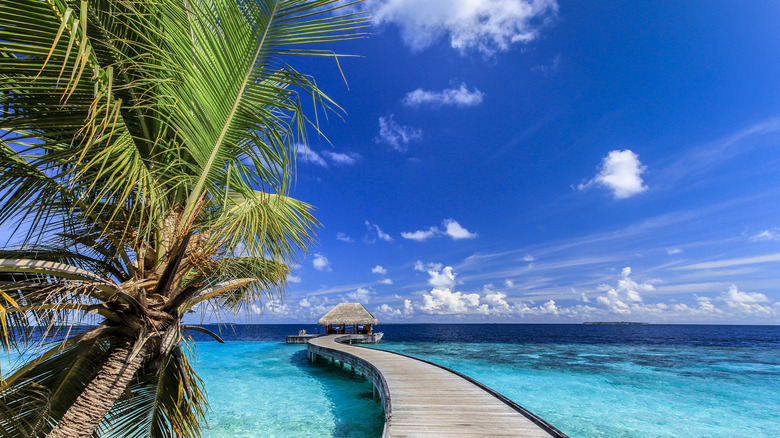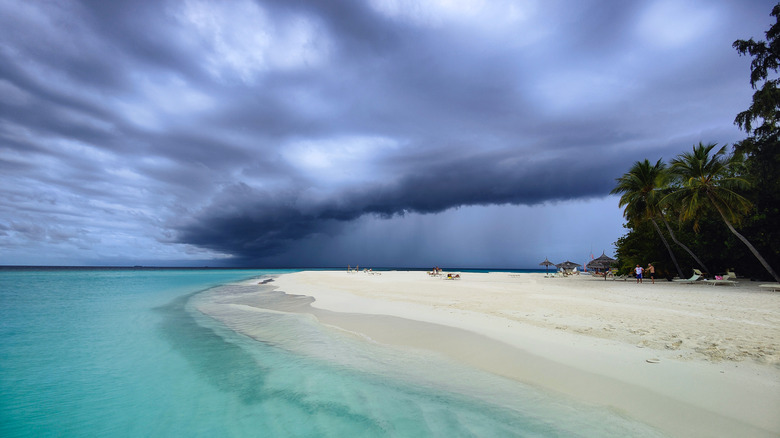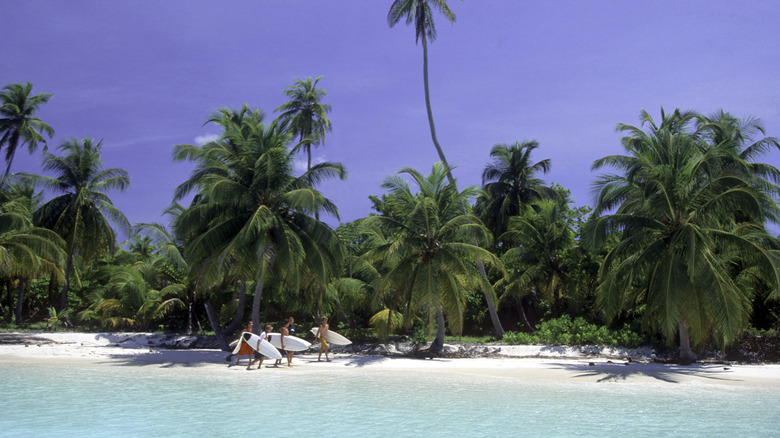The Best Time Of Year To Visit The Maldives For A Dry And Pleasant Vacation
For many, the Maldives — a low-lying archipelago in the Indian Ocean — is the ultimate bucket-list destination. Known for its pristine white-sand beaches, crystal clear turquoise waters, and one-of-a-kind luxury resorts with overwater villas, this tropical paradise attracts more than 1 million visitors annually. The Maldives is considered a top travel destination for romantic honeymoon breaks, as well as being a perfect option for families with its kid-friendly resorts. However, given its remote location and higher travel costs, planning a trip to the Maldives requires careful consideration. This is especially true when choosing when to visit to truly make the most of the trip and enjoy all the fun things to do in the Maldives.
While the islands offer warm temperatures year-round, typically ranging between 77 and 90 degrees Fahrenheit, the local weather is divided into two distinct seasons: dry and wet (also referred to as South West Monsoon). Unlike Europe or North America's four-seasons pattern, the Maldives' tropical climate brings varying levels of rainfall and sunshine throughout the year. Timing your visit to the dry season can ensure optimal conditions for a memorable and pleasant vacation experience.
Dry season vs. wet season in the Maldives
Dry season, from November to April, is the most popular time to visit the Maldives. During this period, expect sunny skies, calm seas, and excellent water visibility, perfect for snorkeling and diving (and enjoying the Maldives' glow-in-the-dark beach at night). Those interested in the underwater world will find it easier to spot marine life like sharks and coral reefs. However, this peak season, with its unbroken sunshine, also brings higher prices and more crowds. March is typically the hottest month overall, making it ideal for sunbathing and beach activities, while November is considered the coolest.
Contrastingly, the wet season from May to October brings heavier rainfall, overcast skies, and rougher seas. While marine life excursions, beach days, and travel plans may be disrupted (seaplane travel in particular), the wet season offers more affordable travel options. Rainfall is often short-lived, and you can still enjoy stretches of sunshine. September sees the heaviest rain, but visitors traveling during this period often find quieter resorts and better deals.
The Maldives receives plenty of sunshine year-round, with up to 11 hours of daylight during the dry season and 7 to 9 hours during the wet season, ensuring there is always time to soak in the beauty of the islands or catch one of its mesmerizing sunsets.
Other factors to consider when planning your Maldives trip
For those seeking the driest weather and peak conditions, the dry season is the obvious best choice. However, budget-conscious travelers may find shoulder seasons, such as late April or late October, to be a great compromise, offering fewer crowds and lower prices with relatively favorable weather. The Maldives offers diverse travel experiences across its 1,192 islands, only 200 of which are inhabited. Your choice of travel dates may depend on your priorities and what you hope to get out of your visit. For example, July and August are ideal for spotting turtle hatchlings, while May to September are the best months for surfing, thanks to stronger waves during the wet season. Independence Day is also celebrated during the wet season in July, making it an ideal time to enjoy local culture and join in the festivities.
It's also worth noting that rainfall varies by region, with the southern atolls experiencing more rain than the northern ones. This may be worth considering when researching your accommodation options. For those seeking a more relaxed atmosphere with fewer crowds, traveling during off-peak times can offer serenity, even if there's a higher chance of rain. It may also be possible to extend your stay during this time, as the overall costs are lower, allowing your budget to accommodate a longer visit. Regardless of the month or season, the Maldives promises stunning landscapes, unique wildlife encounters, and unforgettable experiences.


